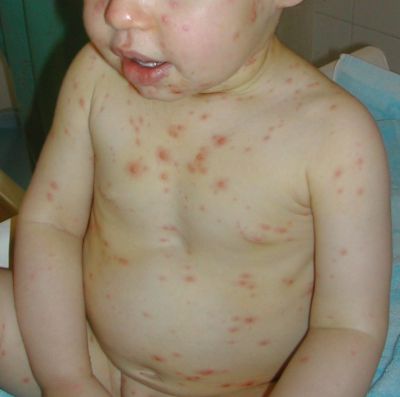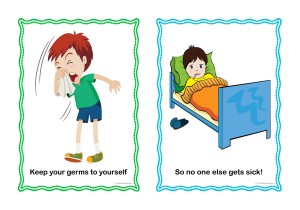Chickenpox is a viral illness. The chickenpox virus is also called varicella virus or varicella zoster virus. It is the same virus that can cause shingles.
Chickenpox Symptoms
Chickenpox usually starts with one spot, but more spots quickly appear, with fever, headache, runny nose, a cough and feeling very tired. The rash starts on the chest and back, and spreads to the face, scalp, arms and legs. The rash can develop all over the body, inside the ears, on the eyelids, inside the nose and within the vagina, everywhere. The rash continues to spread for three or four days. It is usually very itchy.
Within a few hours after each spot appears, a blister forms. It may appear full of yellow fluid. After a day or so, the fluid turns cloudy. These spots are easily broken and form a scab. The spots heal at different stages, some faster than others, so your child may have the rash in several different stages at once. Some kids breeze through chickenpox with just a few spots. Others have a terrible time with hundreds of itchy spots. In families with several kids, it can last for weeks, because of the relatively long incubation period.
Incubation period
A parent doesn't always know when a child has been exposed to chickenpox. Some children can come into contact with chickenpox and do not catch it. But the general rule is that chickenpox will show up about 10 to 21 days after your child has come into contact with an infectious person.
Infectious period
Chickenpox is a highly catching, common childhood disease. Your child is infectious from two days before the rash appears and stays infectious until all the blisters form scabs. Generally, this takes 7 days. Children must stay away from daycare or school while they are infectious. The virus is easily spread when an infected person sneezes or coughs. You can catch chickenpox from clothing that has fresh discharge from the rash of an infected person. Once all the spots have formed scabs, the person is no longer infectious. Your child may go back to school seven days after the first spots appear, as long as the spots are all scabbed over.
Chickenpox is most common in children between the ages of 2 years and 10 years. If one child in your household gets it, it is almost certain that any others who have never had chickenpox will get it next.
Treatment
- Most children do not need any treatment for chickenpox. Calomine LotionTM can be put on the spots to help relieve the itching.
- For fever or pain, give your child PanadolTM or TylenolTM. Never give your child aspirin as this may increase the risk of Reyes Syndrome, which is a rare and serious illness.
- Chickenpox can be prevented by immunisation.
Preventing scarring
Secondary bacterial infection of the spots can be caused by your child scratching, which can lead to scars.
To help prevent scarring from the spots:
- Dress your child in lightweight pyjamas or clothing.
- Clip your child's fingernails as closely as you can.
- Try putting mittens on the hands of very young children.
- Try 20-minute baths, three times a day, with baking soda or an oatmeal type bath product in lukewarm water.
- Change your child's clothes and bed sheets daily.
- Apply a soothing lotion such as Calomine LotionTM.
- If your child is fidgety and wants to scratch the spots, your doctor may suggest an anti-itch medicine.
Remember
- Most cases of chickenpox are mild and children get better completely.
- Scarring can happen if your child scratches the spots and they get infected.
- For fever or pain, give your child Panadol or Tylenol, not aspirin (make sure the dose of medication is recommended by your child's doctor or pharmacist).
- Your child needs to see a doctor if the child has a very high fever or is very ill, such as being very drowsy, breathing fast or vomiting a lot.
References
Aussie Childcare Network acknowledges the co-operation of The Children’s Hospital at Westmead, Sydney Children’s Hospital and Kaleidoscope, Hunter Children’s Health Network in making this fact sheet available.
Disclaimer: This article is for education purposes only. Please consult with your doctor or other health professional to make sure this information is right for your child.










